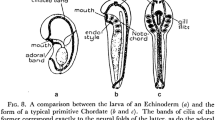Abstract
Two approaches to an integration of evolution and development are often distinguished, one “neo-Darwinian” and the other “structuralist”. Should these approaches in turn be integrated? Kelly Smith recently stated that we need a “more complete” theory of biological order, suggesting integration as the ideal. In response to him, I argue that a recognition of different types of scientific questions and causal explanation is more urgent. Do we understand development when we know the crucial factors in the process of differentiation, or rather when we know the laws that govern the transformations of fields? Without a recognition of these different explanatory ideals, “integration” is likely to have the character of annexation.
Similar content being viewed by others
References
Frankel, J.: 1990, ‘The Evolution of Development’,Evolution 44(2), 465–467.
Gifford, F.: 1990, ‘Genetic Traits’,Biology and Philosophy 5, 327–347.
Goodwin, B.C.: 1984, ‘Changing from an Evolutionary to a Generative Paradigm in Biology’, in: J.W. Pollard (ed.),Evolutionary Theory: Paths into the Future, Wiley & Sons, 99–120.
Goodwin, B.C.: 1988, ‘Problems and prospects in morphogenesis’,Experientia 44, 633–637.
Goodwin, B.C.: 1989, ‘Evolution and the Generative Order’, in: Brian Goodwin and Peter Saunders (eds.),Theoretical Biology, Edinburgh University Press, 89–100.
Gould, S. J.: 1989, ‘A Developmental Constraint inCerion, with Comments on the Definition and Interpretation of Constraint in Evolution’,Evolution 43, 516–539.
Gould, S.J.: 1991 (1989),Wonderful Life, Penguin.
Hart, H.L.A. and T. Honoré: 1985 (1959),Causation in the Law, Oxford University Press.
Hesslow, G.: 1988, ‘The problem of Causal Selection’, in: D.J. Hilton (ed.),Contemporary Science and Natural Explanation, New York University Press, 11–32.
Kuhn, T.S.: 1977, ‘Concepts of cause in the Development of Physics’, inThe Essential tension, University of Chicago Press.
Longino, H.E.: 1990,Science as Social Knowledge, Princeton University Press.
Mackie, J.L.: 1974,The Cement of the Universe, Oxford University Press.
Mill, J.S.: 1973 (1843),A System of Logic, University of Toronto Press.
Oyama, S.: 1985,The Ontogeny of Information, Cambridge University Press.
Raff, R.A. and Kaufman, T.C.: 1983,Embryos, Genes and Evolution, Macmillan.
Van Fraassen, B.C.: 1980,The Scientific Image. Oxford University Press.
Smith, K.C.: 1992, ‘Neo-Rationalism Versus Neo-Darwinism: Integrating Development and Evolution’,Biology and Philosophy 7, 431–451.
Steen, W.J. van der: in press, ‘Toward Disciplinary Disintegration in Biology’,Biology and Philosophy.
Author information
Authors and Affiliations
Rights and permissions
About this article
Cite this article
Van Der Weele, C. Explaining embryological development: Should integration be the goal?. Biol Philos 8, 385–397 (1993). https://doi.org/10.1007/BF00857685
Issue Date:
DOI: https://doi.org/10.1007/BF00857685




